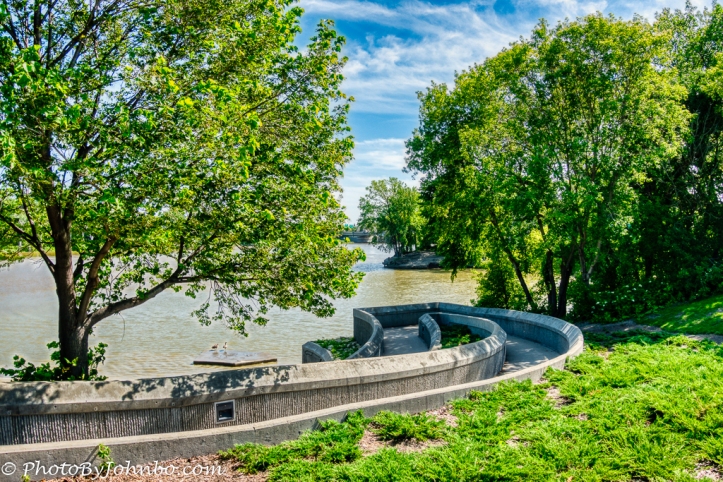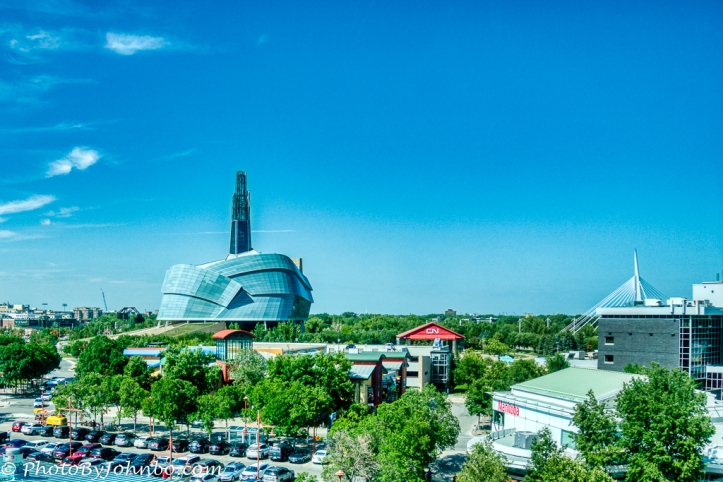Though it was through Civil Air Patrol that my volunteer service brought me to visit our neighbors north of the border, we stayed a couple of extra days to take in some of the historic sites that are popular with visitors to the area. Our friend, Vern, from the Manitoba Air Cadet League brought us to the area known as The Forks after our first day of “official activities.” Our first stop is an observation tower at the eastern edge of The Forks Market. The observation deck at the top of the six story attraction is free and accessible by either stairs or an elevator. The view of the river in the opening shot along with a few other shots in this post was captured from the tower.
The Forks area is so named because of it’s location at the confluence of the Red and Assiniboine rivers. One of the many attractions is a river walk similar in design, though not as well developed as the famed River Walk in San Antonio, Texas. Unfortunately, due to very high water levels this summer, the River Walk was completely under water. The shot above features one of the ramps built to facilitate access to the walk. Given the current conditions, the ramp was safety blocked at the upper end.
 Another view of the River walk demonstrates the high water level as this shot shows the railing along the walk which much of this year (2019) was open only to the water fowl in the area. No matter, between the shops and eating places around The Forks Market and the many other attractions in the area, we found ourselves with no shortage of activities. In the four day visit, we were to sample other attractions two more times. You could spend much of a week in the area and not run out of things to do there.
Another view of the River walk demonstrates the high water level as this shot shows the railing along the walk which much of this year (2019) was open only to the water fowl in the area. No matter, between the shops and eating places around The Forks Market and the many other attractions in the area, we found ourselves with no shortage of activities. In the four day visit, we were to sample other attractions two more times. You could spend much of a week in the area and not run out of things to do there.
 At the left of the image above, the observation tower marks the eastern entrance to The Forks Market. The large tented area often features musicians and other performers at certain times of the day. The gold bands on those blue supports are actually historical markers of high waters along the Red River. The lower bands near ground level mark the high water level in the flood of 1950. The upper bands mark the high water level in 1826, Manitoba’s highest recorded flood level at Winnipeg.
At the left of the image above, the observation tower marks the eastern entrance to The Forks Market. The large tented area often features musicians and other performers at certain times of the day. The gold bands on those blue supports are actually historical markers of high waters along the Red River. The lower bands near ground level mark the high water level in the flood of 1950. The upper bands mark the high water level in 1826, Manitoba’s highest recorded flood level at Winnipeg.
From the observation tower, one of the commanding structures in the area is this stunning international architectural icon. The Canadian Museum for Human Rights is the only Museum in the world devoted to human rights awareness and education. In a future post, you and I shall visit some of the attractions there. On the left (not visible from this vantage), is Shea Stadium, home of the Winnipeg Goldeyes, a minor league baseball team that routinely plays against the Fargo-Moorhead Redhawks. On our last night in Winnipeg, we were able to attend a game where we watched our favorite Redhawks get shellacked by the Goldeyes. What was that final score? As I recall, it was 11-3.
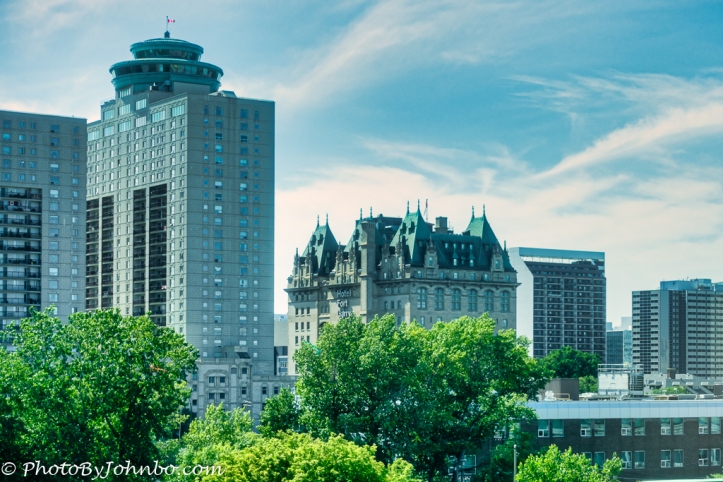 An older building visible on the skyline (center in the photo above) from the observation tower is the Fort Garry Hotel. Opened in December 1913, the hotel served Grand Trunk Pacific Railway executives as well as guests to the city. After closure in 1987 for extensive renovations, the new management reopened the hotel. In 2009, new owners rebranded the hotel creating a spa and conference center.
An older building visible on the skyline (center in the photo above) from the observation tower is the Fort Garry Hotel. Opened in December 1913, the hotel served Grand Trunk Pacific Railway executives as well as guests to the city. After closure in 1987 for extensive renovations, the new management reopened the hotel. In 2009, new owners rebranded the hotel creating a spa and conference center.
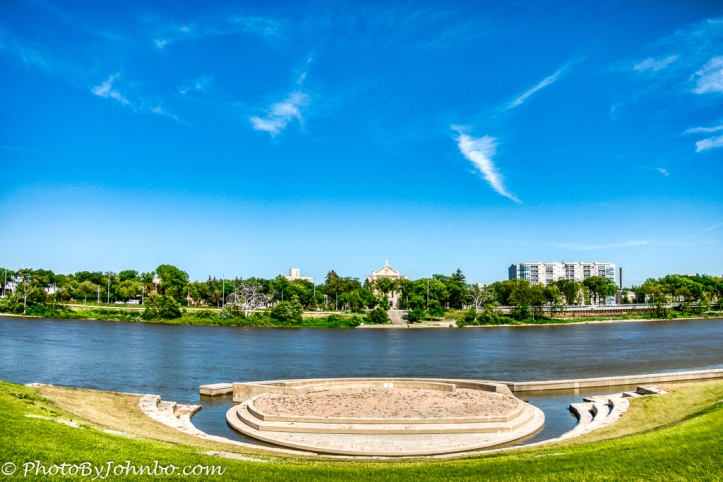 Another view of the River Walk area that was flooded when we visited also looks eastward toward the St. Boniface area of the city. The building directly centered in the image is the Saint Boniface Cathedral, a Roman Catholic basilica which opened to serve the faithful in 1906. Many notables in Manitoba history are buried in the cathedral’s cemetery.
Another view of the River Walk area that was flooded when we visited also looks eastward toward the St. Boniface area of the city. The building directly centered in the image is the Saint Boniface Cathedral, a Roman Catholic basilica which opened to serve the faithful in 1906. Many notables in Manitoba history are buried in the cathedral’s cemetery.
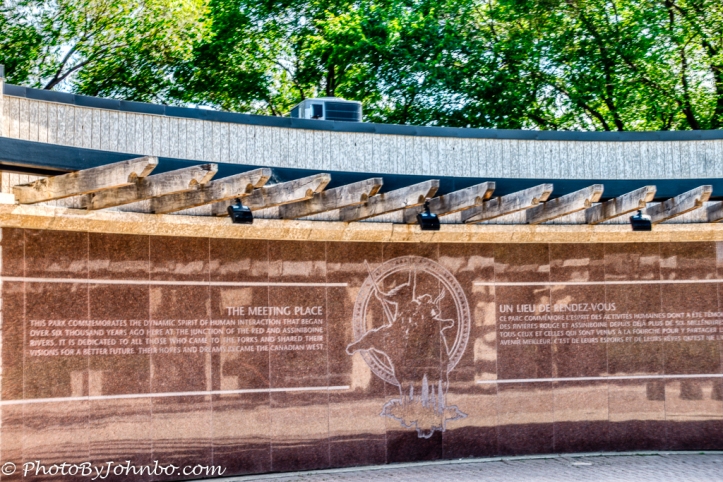 In use as a central meeting place for over 6000 years, the river confluence has served the region for trade, transportation and settlement. The Forks is a National Historic Site. In May through September you can take a 60-minute walking tour with a host providing stories of the characteristics and history of this important economic and political center of Manitoba.
In use as a central meeting place for over 6000 years, the river confluence has served the region for trade, transportation and settlement. The Forks is a National Historic Site. In May through September you can take a 60-minute walking tour with a host providing stories of the characteristics and history of this important economic and political center of Manitoba.
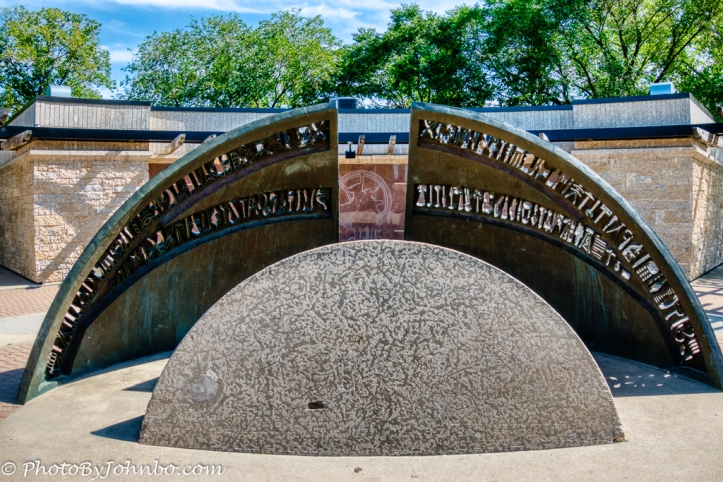 A core part of the park is an area dedicated to the location as a meeting center. One of my favorite stories of early Manitoba history is that during their equivalent of a constitutional convention to set up regional government, so many people participated in the meetings that there wasn’t a big enough building in the young city to support the large group. On one of the coldest winters in the then new city’s history, the group met outside daily to hammer out the required documentation to join the Canadian Union. Imagine today’s politicians having to do this. I now wonder if The Forks is the location of these meetings. It’s something I will have to research.
A core part of the park is an area dedicated to the location as a meeting center. One of my favorite stories of early Manitoba history is that during their equivalent of a constitutional convention to set up regional government, so many people participated in the meetings that there wasn’t a big enough building in the young city to support the large group. On one of the coldest winters in the then new city’s history, the group met outside daily to hammer out the required documentation to join the Canadian Union. Imagine today’s politicians having to do this. I now wonder if The Forks is the location of these meetings. It’s something I will have to research.
On a final note, there are plenty of great restaurants in The Forks Market. Though I usually leave restaurant reviews to my son, Josh, I can make a couple of suggestions. We enjoyed several meals in The Market and can highly recommend Fergies Fish and Chips. The long line is worth the wait. We also had dinner one evening at The Old Spaghetti Factory, also well worth the stop.
John Steiner


